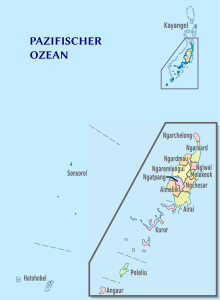States of Palau
Die States of Palau sind die Verwaltungseinheiten des pazifischen Inselstaates Palau. Sie wurden nach dem Vorbild der Bundesstaaten der Vereinigten Staaten mit der Einführung der Verfassung 1980 begründet. Es gibt sechzehn dieser Administrative Regions. Sie nehmen Flächen zwischen 0,7 km² und 61 km² ein und haben zwischen 41 und 11.199 Einwohner (Stand 2020). Palau hat eine hohe Anzahl von Regierungseinrichtungen im Verhältnis zu den Einwohnern. Neben den 16 States besteht ein System von Stammes-Häuptlingen und eine gewählte Legislative in jedem der Staaten.[1]

| Staat | Flagge | Hauptstadt | Fläche km² (ohne Lagune) |
Einwohner (2020) |
|---|---|---|---|---|
| Nördlich von Babeldaob | ||||
| Kayangel | Kayangel | 1,7 | 41 | |
| Babeldaob | ||||
| Aimeliik | Mongami | 37 | 363 | |
| Airai | Ngetkib | 49 | 2.529 | |
| Melekeok | Melekeok | 25 | 318 | |
| Ngaraard | Ulimang | 29 | 396 | |
| Ngarchelong | Mengellang | 8 | 384 | |
| Ngardmau | Urdmang | 30 | 238 | |
| Ngatpang | Ngereklmadel | 35 | 289 | |
| Ngchesar | Ngersuul | 38 | 319 | |
| Ngeremlengui | Imeong | 61 | 349 | |
| Ngiwal | Ngerkeai | 16 | 312 | |
| Südwestlich von Babeldaob | ||||
| Angaur | Ngaramasch | 8 | 114 | |
| Koror | Koror | 58 | 11.199 | |
| Peleliu | Kloulklubed | 17 | 470 | |
| Südwest-Inseln | ||||
| Hatohobei | Hatohobei (Tobi) | 0,7 | 39 | |
| Sonsorol | Dongosaro | 3 | 53 | |
| Palau | Ngerulmud | 416 | 17.614 | |
(Die grünen und roten Pfeile zeigen eine Zu- oder Abnahme der Bevölkerung gegenüber dem Zensus von 2015 an)
Einzelnachweise
- ↑ Carolyn Bennett Patterson et al.: At the Birth of Nations: In the Far Pacific. In: National Geographic Magazine, Oktober 1986: S. 493: „The westernmost among the emerging nations of the Pacific, the Republic of Palau (or Belau), population more than 15,000, is divided into 16 separate states, each with its own governor, lieutenant governor, and legislature. Most state populations are very small, and one wonders if anyone has time for anything but government, American style and democratic though it may be. An example is Peleliu, the tragic island where more than 13,000 Americans and Japanese died during less than three months of fighting, often hand to hand, in the autumn of 1944. Pat and I went to Peleliu from Koror, the republic’s capital, by speedboat, a wave-tossing, rear-slapping 45 minutes, and arrived to discover it was election day, with five candidates running for governor. Although Peleliu claims a population of 2,000 people, only 400 actually live there. More registered voters live in Koror than on their home island, and 800 send votes from Guam. The situation is similar in Palau’s other states. A current joke puts a laugh in the truth. A man walks into a bar in Koror and calls out, „Hey, Governor!“ And half the men in the place stand up. But that’s only the state story. The national government is headed by President Lazarus Salii, followed by a vice president, a cabinet responsible for five ministries, a judiciary, and a legislature with a 16-member house and a 14-member senate. And there’s the hereditary leadership. Each village has ten chiefs, ranked in importance. And, dividing the island group, there are two paramount chiefs. Never, I thought, have so few been governed by so many.“
Weblinks
- Republic of Palau – States. palaugov.pw
- Honorary Consulate of the Republic of Palau to the UK &NI. palauconsulate.org.uk
- Statoids. statoids.com




